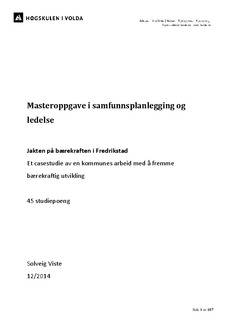Jakten på bærerkraften i Fredrikstad. Et casestudie av en kommunes arbeid med å fremme bærekraftig utvikling
Master thesis

View/
Date
2014Metadata
Show full item recordCollections
- Samfunnsplanlegging [68]
Abstract
Summary
The purpose of this study has been to investigate how Fredrikstad’s work with sustainable development is expressed today after having had sustainable development on their agenda since 1994. The background for this approach is the municipality’s responsibility to promote sustainable development based on the Law for Planning and Building. I have been curious how municipalities tackle this immense and complex challenge. The question I chose for this case study is: How is work with sustainable development expressed I Fredrikstad after having sustainable development on the municipality agenda since 1994? I focused particularly on the social dimension of sustainable development. Knowledge about Fredrikstad municipality’s work to promote a sustainable development is based on information gained through interviews and from available plans and reports. I have examined this information in light of a specific model for sustainable development and several theories I feel are relevant. The concept of sustainable development is perceived to be important but it is difficult to see clearly the connection between dimensions in the concept. The municipality is primarily concerned with the ecological dimension in their role as a community developer and with the social dimension in their role as a service provider. The plan and management system in place testify to the desire to gain a more holistic grip on development. However, it continues to be a challenge to achieve a better connection between the municipality plan (strategic level) and action plans and annual reports (operative level). Fredrikstad has chosen to define sustainable development through actions rather than words. What the municipality considers to be important can be expressed in a “new” model for sustainable development: Sustainability Arrow (Armann, K.A. Nakkerud, M.B. 2008). It is characterized by the following elements: To see the three dimensions of sustainable development in connection with each other (1-3), think longterm (4), facilitate participation (5), develop practice (6), develop knowledge (7), facilitate value debates (8), have a global perspective (Earth).